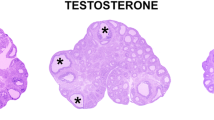Purpose
The effect of gonadotropins on implantation and fetal development in mice was investigated by superovulation with pregnant mare serum gonadotropin and human chorionic gonadotropin. In a previous study fetal growth was found to be highly retarded.
Results
Assessment of implantation in vivo revealed that late implantation did occur. Gestational length was highly extended, the mean number of live fetuses per pregnant mouse was lower and their mean weight significantly reduced. In vitro experiments revealed no significant difference in the rate of blastocyst adhesion and trophoblast outgrowth development. Immunohistochemical staining, however, showed that blastocysts from superovulated mice had smaller trophoblastic outgrowths than control embryos. Staging embryonic development at the time of flushing, however, revealed retarded embryo development in vivo in hormone-treated mice. After correlation with embryonic stage at the beginning of the culture, there was no difference in the size of trophoblastic outgrowths.
Conclusion
Treatment with gonadotropins impaired implantation and embryonic/fetal development. Changes in maternal milieu, rather than in embryo quality, may be responsible for the adverse effects observed.
Similar content being viewed by others
References
Ertzeid G, Storeng R: Adverse effects of gonadotropin treatment on pre- and postimplantation development in mice. J Reprod Fert 1992;96:649
Doyle P, Beral V, Maconochie: Preterm delivery, low birthweight and small-for-gestational-age in liveborn singleton babies resulting from in-vitro fertilization. Hum Reprod 1992;3:425
Elbling L, Colot M: Abnormal development and transport and increased sister chromatid exchange in preimplantation embryos following superovulation in mice. Mutat Res 1985;147:189
Elbling L, Colot M: Persistence of SCE-inducing damage in mouse embryos and fetuses following superovulation. Mutat Res 1989;76:117
Fossum GF, Davidson A, Paulson RJ: Ovarian hyperstimulation inhibits embryo implantation in the mouse. J Vitro Fert Embryo Transfer 1989;6:7
Miller BG, Armstrong DT: Infertility in superovulated immature rats: Role of ovarian steroid hypersecretion. Biol Reprod 1982;26:861
McRae AC, Church RB: Cytoplasmic projections of trophectoderm distinguish implanting from preimplanting and implantation-delayed mouse blastocysts. J Reprod Fert 1990;88:31
Whittingham DG: Embryo banks in the future of developmental genetics. Genetics 1974;78:395
Cordell JL, Falini B, Erber WN, Ghosh AK, Abdulaziz Z, MacDonald S, Pulford KAF, Stein H, Mason DY: Immunoenzymatic labeling of monoclonal antibodies using immune complexes of alkaline phosphatase and monoclonal anti-alkaline phosphatase (APAAP complexes). J Histochem Cytochem 1984;32:212
Wilson ED, Edwards RG: Parturition and increased litter size in mice after superovulation. J Reprod Fert 1963;5:179
Fowler RE, Edwards RG: Induction of superovulation and pregnancy in mature mice by gonadotrophins. J Endocrinol 1957;15:374
de Boer P, van dere Hoeven FA, Wolters EMTJ, Mattheij JAM: Embryo loss, blastomere development and chromosome constitution after human chorionic gonadotropin-induced ovulation in mice and rats with regular cycles. Gynecol Obstet Invest 1991;32:200
Sappino AP, Huarte J, Belin D, Vassali JD: Plasminogen activators in tissue remodeling and invasion: mRNA localization in mouse ovaries and implanting embryos. J Cell Biol 1989;109:2471
Champlin AK, Kuzia SJ, Rice BA, Mobraaten LE: Cell surface characteristics of blastocysts from spontaneously ovulating and gonadotropin-treated mice. Biol Reprod 1987;36:439
Walton EA, Huntly S, Kennedy TG, Armstrong DT: Possible causes of implantation failure in superovulated immature rats. Biol Reprod 1982;27:847
Pollard JW: Regulation of polypeptide growth factor synthesis and growth factor-related gene expression in the rat and mouse uterus before and after implantation. J Reprod Fert 1990;88:721
Author information
Authors and Affiliations
Rights and permissions
About this article
Cite this article
Ertzeid, G., Storeng, R. & Lyberg, T. Treatment with gonadotropins impaired implantation and fetal development in mice. J Assist Reprod Genet 10, 286–291 (1993). https://doi.org/10.1007/BF01204944
Received:
Accepted:
Issue Date:
DOI: https://doi.org/10.1007/BF01204944




